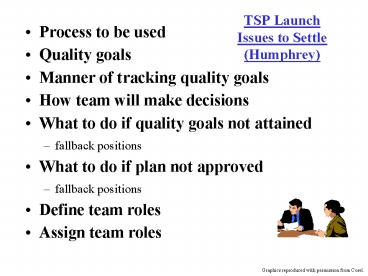TSP Launch Issues to Settle Humphrey - PowerPoint PPT Presentation
1 / 18
Title:
TSP Launch Issues to Settle Humphrey
Description:
Noen gode r d for estimering - 1. Vi har to form l med estimere. Disse m ikke blandes sammen: ... Noen gode r d for estimering - 2 ... – PowerPoint PPT presentation
Number of Views:87
Avg rating:3.0/5.0
Title: TSP Launch Issues to Settle Humphrey
1
TSP Launch Issues to Settle(Humphrey)
- Process to be used
- Quality goals
- Manner of tracking quality goals
- How team will make decisions
- What to do if quality goals not attained
- fallback positions
- What to do if plan not approved
- fallback positions
- Define team roles
- Assign team roles
Graphics reproduced with permission from Corel.
2
To Be Produced at Launches (Humphrey)
- 1. Written team goals
- 2. Defined team roles
- 3. Process development plan
- 4. Quality plan
- 5. Projects support plan
- computers, software, personnel etc.
- 6. Overall development plan and schedule
- 7. Detailed plans for each engineer
- 8. Project risk assessment
- 9. Project status report
3
IEEE 1058.1-1987 SPMP Table of Contents
3.2 Assumptions, dependencies
constraints 3.3 Risk management 3.4
Monitoring controlling mechanisms
3.5 Staffing plan 4. Technical process 4.1
Methods, tools techniques 4.2 Software
documentation 4.3 Project support functions
5. Work packages, schedule budget 5.1
Work packages 5.2 Dependencies 5.3
Resource requirements 5.4 Budget resource
allocation 5.5 Schedule
1. Introduction 1.1 Project overview 1.2
Project deliverables 1.3 Evolution of the
SPMP 1.4 Reference materials 1.5
Definitions and acronyms 2. Project organization
2.1 Process model 2.2 Organizational
structure 2.3 Organizational boundaries
and interfaces 2.4 Project
responsibilities 3. Managerial process 3.1
Managerial objectives priorities
4
Five Process Metric Examples
Compare each of the following with company norms
averaged over similar processes.
- 1. Number of defects per KLOC detected within x
weeks of delivery - 2. Variance in schedule on each phase
- actual duration - projected duration
projected duration - 3. Variance in cost actual cost - projected
cost - projected cost
- 4. Total design time / total programming time
- should be at least 50 (Humphry)
- 5. Defect injection and detection rates per phase
- e.g. 1 defect per class in detailed design
phase
Adapted from Software Engineering An
Object-Oriented Perspective by Eric J. Braude
(Wiley 2001), with permission.
5
(No Transcript)
6
Noen gode råd for estimering - 1
- Vi har to formål med å estimere. Disse må ikke
blandes sammen - Anbud. Hovedsaken er å vinne en kontrakt
- Kostnad. Hovedsaken er et nøyaktig estimat over
hva det egentlig vil koste å gjøre jobben - Bruk flere estimeringsmetoder. Alle metoder har
sine sterke og svake sider.
7
Noen gode råd for estimering - 2
- Estimatene må ledsages av en forklaring for
eksempel hvilke forutsetninger vi har gjort? - Bruk folk med erfaringer fra prosjekter som
likner på det vi skal estimere nå. - Ta hensyn til usikkerheten i estimatene.
- Sørg for at vi lærer av våre erfaringer også her.
8
Estimation methods
- We will in this course look at three methods for
cost estimation - COnstructive COst MOdel COCOMO
- Use case points
- Work Breakdown Structure - WBS
- We recommend that you use usecase points or WBS
in Fellesprosjektet
9
Basic COCOMO Formulae (Boehm)
Effort in Person-months a???KLOC
b Duration c??? Effort d
Software Project a b c
d Organic 2.4 1.05 2.5 0.38 Semidetached 3.0
1.12 2.5 0.35 Embedded 3.6 1.20 2.5 0.32
Due to Boehm Bo
10
Meaning of the COCOMO Formulas (Boehm)
(1) Effort for increasing LOC ( y 3x 1.12 )
(2) Duration for increasing Effort ( y
2.5x 0.35 )
lt 1
exponent
gt 1
Applies to design through integration
test. Effort total person-months required.
11
Computing COCOMO Case Study Models
Adapted from Software Engineering An
Object-Oriented Perspective by Eric J. Braude
(Wiley 2001), with permission.
12
Basic COCOMO
The unadjusted COCOMO equation describes a
nominal project in in organization.
This equation needs to be calibrated for each
company and development method.
13
Cost drivers - 1
Most projects are not nominal. In order to
estimate the real cost we need to estimate how
much they deviate for a nominal project.
14
Cost drivers - 2
The COCOMO deviation measure is defined as
follows
The fis are the cost drivers. They are used to
assess how much each defined project
characteristic deviates from its nominal value.
15
(No Transcript)
16
The complete COCOMO equation
The complete COCOMO equation is this as follows
17
Calibration - 1
- Select N projects where we have size, cost
drivers and cost data available. - Compute the constant a for project k as
- Estimate a as
18
Calibration - 2
Alternatively we can estimate both a and b
through linearization
The cost drivers and KLOC are known for each
project .We can use linear regression to estimate
b and ln(a) and then a.































